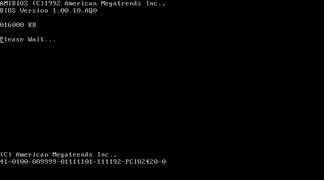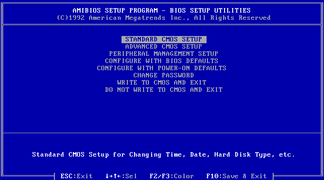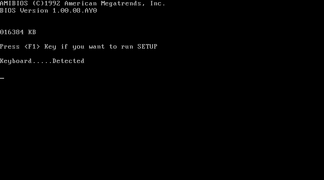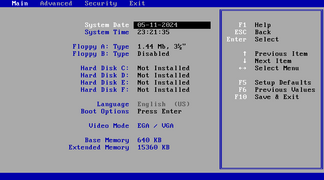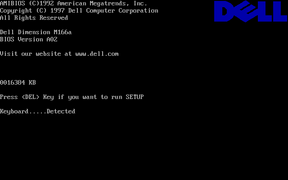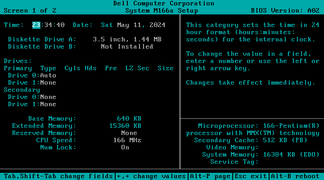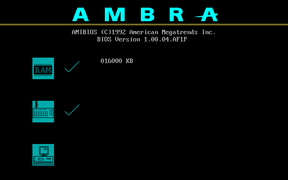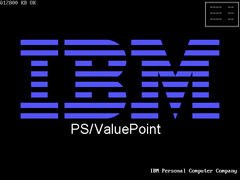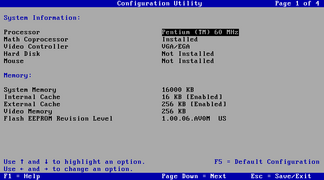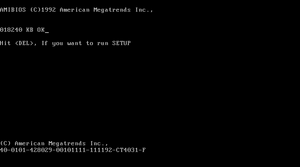
AMI Hi-Flex BIOS, commonly nicknamed "AMI Color BIOS" by enthusiasts (due to its colorful setup utility), is a version of AMIBIOS released by American Megatrends. Compared to its predecessor, the AMI Plus BIOS, it introduced an entirely new setup utility (with more options) and a new ROM identification string format (which would also be used for all newer AMIBIOS versions and earlier instances of Aptio, although with minor changes).
AMIDIAG, a system diagnostics tool whose limited version was shipped with some Plus BIOS ROMs, was no longer included with this version. Although some of AMIDIAG's features remained in the new setup utility.
Setup Utility
The new utility lists setup options in menus, with each menu containing related options on a single page to fit more of them. Unlike AMI Plus BIOS' grayscale utility, the new utility contains various color presets for customization (although some of them are grayscale), as seen below. The preset can be changed with the F2 and F3 keys on the keyboard.
-
Colour 1 (often default)
-
Colour 2
-
Colour 3
-
Colour 4
-
Colour 5
-
Colour 6
-
Colour 7
-
Colour 8
-
Colour 9
-
Colour 10 (default for early Intel fork)
-
Colour 11
-
Colour 12
-
Colour 13
-
Colour 14
-
Colour 15
-
Colour 16
Technical limitations
Lack of Logical Block Addressing (LBA) support
Similar to the AMI Plus BIOS, hard drives of up to 32 GB in capacity can be configured in the setup utility. However, due to the lack of LBA (Logical Block Addressing) in most revisions, only up to 504 MB can actually be utilized. Although, some late revisions of Hi-Flex BIOS support LBA. On these revisions, LBA can often be enabled in the Advanced CMOS Setup menu. Various workarounds also exist for this limitation, such as using Ontrack Disk Manager.
New ROM identification string format
As mentioned, Hi-Flex BIOS has introduced the string format that was in use for all newer versions of AMIBIOS and all versions Aptio until 2020 (when the string was finally removed), with only some slight changes over time.
C: Processor architecture, R: ROM size, MMMM: Manufacturer/OEM identification code, FFFFFFFF: BIOS feature identification (often 00101111), SSSSSS: BIOS compile date OR subcore release date, DDDDDDDD: BIOS identifier, Project: BIOS project ID (no maximum characters), K: Keyboard controller (KBC) ID
CR-VVVV-00MMMM-FFFFFFFF-SSSSSS-DDDDDDDD-Project-K
Note: The project ID section is only present on later cores of AMIBIOS 6 and later releases. The keyboard controller ID is also not used on AMIBIOS 07.00.xx, AMIBIOS 8 and Aptio.
Example string: 61-1108-001169-00101111-071595-440BX/ZX-1440B000-H
This string is for a 11.08 revision ("1108") 128 KB ("1") size AMIBIOS 6 ("071595", main subcore for it) for a motherboard for 686 architecture processors ("6") with Intel 440BX or 440ZX chipset ("440BX/ZX") and an AMIKEY-2 clone keyboard controller ("H") made by MSI ("1169").
For a list of codes for each field, click here.
Intel fork
Main page: List of BIOS and UEFI firmware used by Intel motherboards
Intel has forked AMI Hi-Flex BIOS core version 111192 and used it on most of their motherboards manufactured from 1993 to 1997 (when they switched to PhoenixBIOS 4.0 Release 6.0 instead). Early versions of this fork are not much different from the original AMI version, while later versions had a lot more differences. This fork was also used by most OEMs that licensed Intel motherboards for their computers, although sometimes with their own branding and occasionally even their own setup utility (like with Dell and IBM).
-
Early POST screen (Intel Classic/PCI)
-
Early setup utility (Intel Classic/PCI)
-
New POST screen (Intel Classic/PCI ED)
-
New setup utility (Intel Classic/PCI ED)
-
Late POST screen in 8x19 font (Intel AP440FX)
-
Late setup utility in 8x19 font (Intel AP440FX)
-
Dell Dimension M166a POST screen (based on Intel Hannibal+ motherboard)
-
Dell Dimension M166a setup utility
-
AMBRA (IBM) DP60PCI POST screen (based on Intel Premiere/PCI ED)
-
IBM PS/ValuePoint P60 POST screen (based on Intel Premiere/PCI LP/LPX)
-
IBM PS/ValuePoint P60 setup utility
















